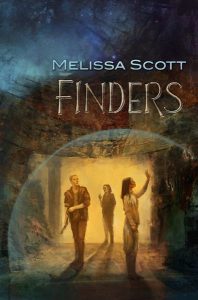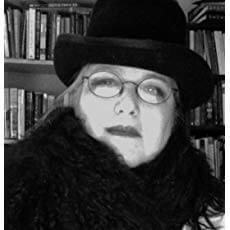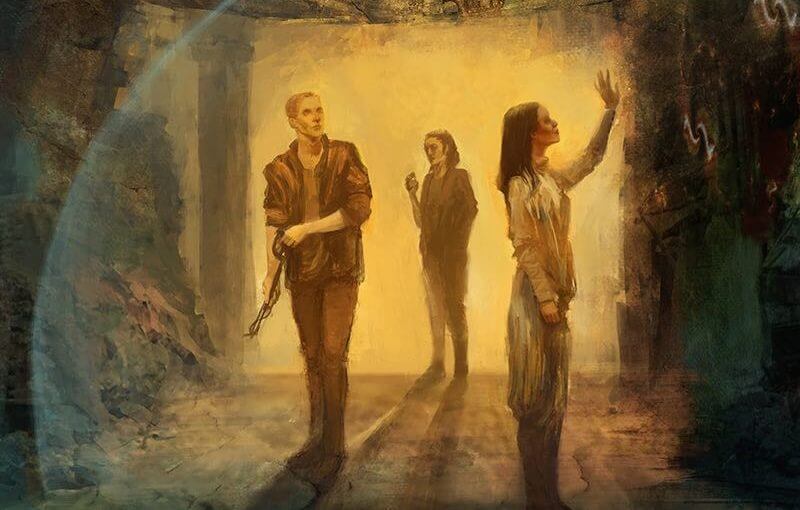Eye on the Indies: A Look at Indie Authors
and their Publishers
By Lanie Tankard, Indie Book Review Editor
FINDERS by Melissa Scott (Cambridge, MA: Candlemark & Gleam, December 10, 2018). 372 pp, $20.95 paperback, ISBN 9781936460885; $5.99 e-book, ISBN 9781936460878.
“…to hope, till Hope creates
From its own wreck the thing it contemplates….”
— Percy Bysshe Shelley,
Prometheus Unbound, Act IV

Time and space become shapeshifters in Melissa Scott’s latest novel, Finders. This fascinating genre mashup embodies ancient myths in future worlds, while remarking metaphorically on issues in the present. Scott has fused space + adventure + quest + science + magic + mythology into a realm somewhere between dystopia and never-never land. Literary, cultural, and scientific allusions abound in so many creative “winks” it’s hard to put the book down.
The novel combines two stories Scott had written for science-fiction collections about “heroes who happen to be women, doing whatever they would do in universes where they’re fully human.” Gardner Dozois selected the stories for two volumes of The Year’s Best Science Fiction. “Finders” (Vol. 31, 2014) originally appeared in The Other Half of the Sky and “Firstborn, Lastborn” (Vol. 34, 2017) in To Shape the Dark, both edited by Athena Andreadis.
The Finders plot follows a well-drawn threesome: Cassilde Sam (a salvage operator), Dai Winter (a salvor), and Summerland Ashe (a scholar). Partners “Silde” and Dai operate a ship called the Carabosse, “just another pre-war Fairy-class scout bought surplus and converted for salvage.” (Carabosse was the antihero in Tchaikovsky’s 1890 ballet, The Sleeping Beauty—the fairy godmother not invited to the palace.)
In this “insectoid” ship, Silde and Dai deal in interstellar commerce with artifacts of the Ancients salvaged from beyond the universe. They’re strapped for funds and need to make another big salvage run to recoup. The technology humanity uses in Finders makes it possible to navigate through hyperspace powered by color-coded Elements. A promising debris field has come to light that could yield many Elements and set Silde and Dai up with a lucrative payload.
They need a scholar for the mission though, so Silde sends out a notice. Ashe applies. He had worked on the Carabosse with Silde and Dai before (“their first scholar, partner and lover and friend”), until he deserted during a lengthy interplanetary war referred to as the Trouble. Ashe went to work for the other side (the Entente) against Silde and Dai’s (the Verge). Now Ashe is applying to do Ancestor salvage with them again on the wreckage of a sky palace missing in long orbit for over a century. He would bring knowledge of the opposition—but can they trust him? They take the chance.
Embedded in the storyline is an intriguing subplot about immortality. Toxic snow falls on the Burntover Plain as the narrative begins, just as Silde is coming to terms with her diagnosis of debilitating Lightman’s—an incurable and fatal disease.
As with many themes in Finders, Scott here combines various actual ideas into a credible mélange of something altogether new. Silde’s illness is a possible play on neuroendocrinologist Stafford Lightman’s studies of stress-related disease—as well as the character Cal Lightman on the television show “Lie to Me,” based on the nonverbal deception research of psychologist Paul Ekman about micro expressions.
Scott taps into synapse plasticity to develop the concept of blood-transmitted Gifts left by the Ancestors that create a biochemical change enabling immediate healing and thus eternal life. When Silde gets a Gift, she becomes hunted. Cassilde’s name itself suggests the legend of Saint Casilda of Toledo and her cure.
Attacked by space pirates, the Carabosse takes off to beat them to the most formidable artifact the Ancestors created, one that practically destroyed them during the first Long Dark. Now Silde is feeling communications from these ancient Titans through her Gift. Are they telling her the truth? She must become a reverse Pandora to contain the power before her adversary unleashes it—and extinguishes her civilization.
Throughout their expedition, Silde, Dai, and Ashe sustain themselves with tea. When Ashe worked for the Other Side, he developed a fondness for coffee, but now he brews up kettle after kettle of tea for his shipmates: “Verge versus Entente again, the teas of the far-flung Edge systems poised against the coffee popular in the Core, where the stars lay close enough to each other that the Ancestors had knit them into retimonds, worlds and systems linked by a single communications web.”

Scott weaves in university grants, artificial intelligence (AI), and data motes as wearable devices. Nor does she forget e-commerce, data ownership, and the university/government desire for both. She incorporates silent signs—perhaps in reference to DeYarmond Edison? Maybe signifying nonverbal behavior? Or both? Scott warps and wefts the threads of her tale leaving no negative space. A large part of the appeal is her use of myth and history alongside science and adventure: We run across Aeolus, St. Elmo’s fire, and a black mirror.
The seamless time/space continuum Scott posits is both intellectually captivating and a timely read. We are indeed in “outer space” now, at our most distant point in the history of space exploration. As 2019 began, NASA’s New Horizons spacecraft was four billion miles from Earth, a few years after it brushed by Pluto. This interplanetary space probe launched in 2006 has now zipped past a Kuiper Belt Object (KBO) nicknamed Ultima Thule, and will beam back observations of that small frozen world in the next couple years.
The romantic triad of Scott’s space opera takes us along for the ride as the author speculates what might be out there beyond the dark—and, in reverse, how our civilization might appear in some future time looking back. The Carabosse has left the universe far behind. This novel lives in the multiverse—nay, the omniverse, the quantum multiverse, or the Level 2 multiverse. Melissa Scott imagines them all. She’s at the top of her game here.
Finders is believable worldbuilding at its best.
Melissa Scott is a prolific author of more than thirty original novels and several short stories. She’s written ten science fiction novels, five novels in The Astreiant series (two with Lisa Barnett), a trilogy (The Roads of Heaven), a duology (The Persephone), and two alternate histories (one with Barnett). In addition, she’s coauthor with Jo Graham of five in The Order of the Air series and with Amy Griswold of two in the Mathey & Lynes series. Plus almost a dozen novels as authorized tie-in fiction to Star Trek’s Deep Space Nine and Voyager as well as Stargate’s Atlantis and SG–1 (about half coauthored with Graham and Griswold).
Scott’s first novel came out in 1984. Two years later, she won the John W. Campbell Award for Best New Writer from Dell Magazines at the Hugo Awards. Scott has garnered three Lambda Literary Awards: 1994, 1995, and 2001 (the last with Barnett). She was short-listed for the 1994 James Tiptree, Jr., Award, which encourages the exploration and expansion of gender. Scott has won four Gaylactic Spectrum Awards: Her novel Shadow Man was the 1999 People’s Choice winner.
Scott has an undergraduate history degree from Harvard University and earned a PhD in Comparative History from Brandeis University. Her dissertation foreshadowed her fiction themes: “The Victory of the Ancients: Tactics, Technology, and the Use of Classical Precedent.”
Publisher: Candlemark & Gleam
 Indie publisher Candlemark & Gleam in Cambridge, MA, is almost a decade old. Founded in 2010 by Kate Sullivan, the speculative fiction press put out twenty-eight titles in its first five years. Athena Andreadis acquired C&G in 2015 and continues to publish books in the science fiction, fantasy, and young adult genres—in addition to anthologies.
Indie publisher Candlemark & Gleam in Cambridge, MA, is almost a decade old. Founded in 2010 by Kate Sullivan, the speculative fiction press put out twenty-eight titles in its first five years. Athena Andreadis acquired C&G in 2015 and continues to publish books in the science fiction, fantasy, and young adult genres—in addition to anthologies.
Andreadis retired as associate professor of cell biology from the Shriver Center of the University of Massachusetts Medical School. With a BA from Harvard University and PhD from Massachusetts Institute of Technology, she’s done research in molecular neurobiology. Andreadis has publications ranging from articles on “Tau Splicing and the Intricacies of Dementia” to a book titled To Seek Out New Life: The Biology of Star Trek—in addition to essays and poetry. She coedited two feminist science-fiction anthologies: The Other Half of the Sky and To Shape the Dark.
C&G’s motto is “New worlds, new adventures, new ideas,” stating: “Candlemark & Gleam is proud to be home to explorers who yearn to walk under strange skies, to elicit and nourish fiction that shapes the dark.” Look for The Marten and the Scorpion by Australian author Robin Shortt, due out this fall. Manuscript submission guidelines are on the website.
Copyright 2019 Woven Tale Press LLC. All Rights Reserved.

